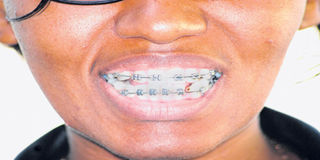Bad teeth plagued Agnes’s confidence for almost 27 years

Agnes with her current treatment of braces. PHOTO | COURTESY
What you need to know:
- For good 27 years, Agnes never really learned how to smile like her other peers because of the state her teeth were in and this affected her confidence as she grew up.
Weighed down by bad teeth, aches and lack of awareness, Agnes Tesha, a 28-year-old resident of Tabata, Dar es Salaam was at her wits’ end when she made the life-changing decision to do something about the condition.
For good 27 years, Agnes never really learned how to smile like her other peers because of the state her teeth were in and this affected her confidence as she grew up.
She always became engrossed on other people’s teeth, absorbed by the thoughts on why theirs looked so good and hers were so bad.
Recalling her bygone days, Agnes tells Your Health, “Most of the times, I used to cover my mouth when laughing to avoid being embarrassed in front of my friends, colleagues or relatives. These things stay with you and becoming conscious about it gets to you.”
Before the treatment
Agnes’s teeth were not in a good position since childhood. Her upper and lower teeth did not match, especially when her mouth remained closed. She was neither at ease when chewing certain foods nor comfortable laughing in public.
“I began researching about the misalignment of the teeth and the possible medical solutions to it. I remember one day in 2014, I was running errands around Posta bus stop in Dar es Salaam when I saw an outdoor advert which had picture of a person with a similar condition like mine. The picture demonstrated the person’s before and after treatment look,” Agnes recalls.
Agnes was extremely inspired and motivated because finally the search for medical assistance to improve her teeth was over. She jotted down the number of the clinic.
The next day Agnes communicated with the specialists for inquiry, but unfortunately she could not afford the treatment costs because they demanded Sh3.5 million.
But Agnes did not lose hope. “Few days later, I met up with my friend who directed me to consult specialists at the dental department of Muhimbili National Hospital (MNH). Upon diagnosis at the hospital, it was revealed that I have a condition medically known as malocclusion, which is improper positioning of the teeth that required minor medical surgery to reposition the teeth back into a normal alignment.”
About Agnes’s condition
Malocclusion literally means poor/bad bite. Some children’s jaws and teeth do not develop properly. Malocclusion refers to crooked, misaligned teeth and a fault in the relation between the bottom and top set of teeth (the two dental arches).
This may develop because of injury to the teeth or facial bones, frequent thumb sucking, or for reasons unknown.
However, it is pronounced that frequent thumb sucking (or finger sucking) can result in localised deformation of the teeth and supporting bone. In order to restore a natural improvement, the thumb sucking habit has to be stopped.
Generally, the condition does not affect physical health, this is due to the fact that the condition is not termed as a disease, and it is just a variation in the normal position of teeth.
The condition may impact on the shape of the person’s face and the appearance of their teeth, which can lead to embarrassment, lack of self-confidence, and even depression.
A specialist’s view
Dr Noman Atiq, a Consultant Orthodontist at the Aga Khan Hospital told Your Health, for a person who has been diagnosed with malocclusion, the treatment usually does not commence until the child is about 11 or 12 years old.
Adding to that, Dr Atiq says that some times it may start even early, especially if the child has abnormal oral habits like thumb sucking, tongue thrusting, lip biting, and also in cross bite cases.
“Children with a cleft lip and palate may require orthodontic treatment before their adult teeth have developed completely,” he said.
Dr Atiq also warned that patients who have not reached good oral hygiene standards beforehand are much more likely to suffer from tooth decay after treatment begins.
“A misaligned or malformed jaw can also cause a misaligned bite. They can occur in any or all three dimensions. Generally it can express as protruding jaws, a lower jaw slanted to one side or an open bite,” Dr Atiq said.
In a recent study titled, ‘Prevalence of malocclusion and its associated factors among preschoolchildren in Kinondoni and Temeke Districts, Tanzania,’ it was found that sucking habit was the significant factor associated with malocclusions in children aged 3-5 years old.
Parents of pre-school children were interviewed regarding their socio-demographic details and their child’s sucking habits. Clinical examination was performed to each child to assess malocclusions.
The overall prevalence of malocclusion was 32.5 per cent.
After controlling for socio-demographic variables, current sucking habits and sex remained significant determinants for having an open bite with odds ratios of 13.5 and 2.2, respectively.
The study showed that more than one third of pre-schoolchildren in the two districts had one or more forms of malocclusions. Open bite was the most common vertical malocclusion trait which was significantly related to sucking habits and child’s sex.
Agnes’s big step
Last August, Agnes was instructed to go back to MNH for the commencement of the treatment. “I did a second screening, and I was told that the repositioning process would take at least a year or a year and few months approximately,” says Agnes.
She was required to pay at least Sh2 million as treatment cost, but the good thing is, she was allowed to pay in installments and that’s why it was easy for Agnes to finally make the big life changing step.
“It is cheaper to bear the treatment cost at a local hospital as compared to what might require abroad. I even once thought of seeking medical assistance abroad but the cost was very high. It was rounding up to USD3000-4000, according to details I found on internet,” cautions Agnes.
Treatment with fixed braces typically takes 2 to 3 years. During this period, the patient needs to visit the orthodontist every 4-8 weeks.
However, Agnes’s dentist informed her that the complete rearrangement of her teeth (repositioning process) normally varies between a year and a year and a half because the damage was not big.
In the process of rearranging the teeth, the specialist advised that at least two teeth were supposed to be removed so as to give other teeth a space to develop properly.
“That day I lost four teeth, two in the bottom set and two in the top set (the two dental arches) respectively,” Agnes recalls.
Wires in the shape of an arch pass through the brackets and are fixed to the bands. As the arch wire is tightened, tension is applied to the teeth, which over time moves them into proper/normal position.
“For the braces treatment to progress well, it’s important to maintain good oral hygiene, brush after every meal and snack, and avoid hard, sticky foods,” Dr Atiq said. He noted that once braces are removed, the patient is given retainers to wear, in a bid to hold teeth in their new positions. According to Dr Atiq, typically, retainers are worn for several years to prevent the teeth from reverting to their original positions.
Agnes finally learnt how to smile
The procedure was done successfully and Agnes was instructed to visit her dentist once every month forroutine check-ups and replacement of the apparatus.
“I currently feel more comfortable compared to the situation before the procedure was done. I can now laugh and talk smoothly, without feeling shy, in front of my friends, I am now happy,” Agnes tells wearing a huge smile.
She further says, “I would like to call on the people with similar condition to visit the health facilities for medical assistance. They should not be ashamed of themselves because the condition is not a disease.”




